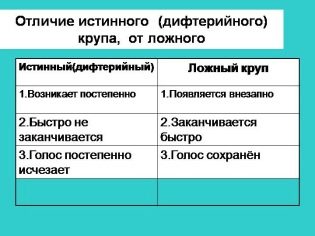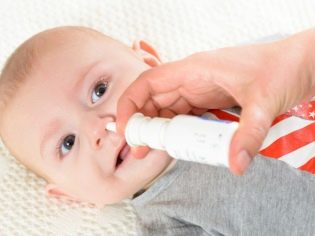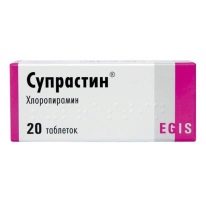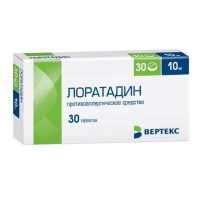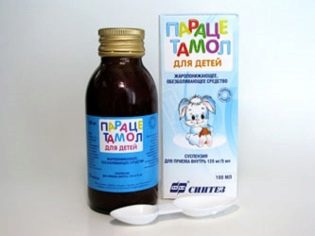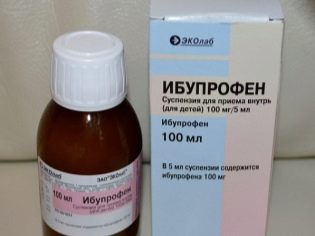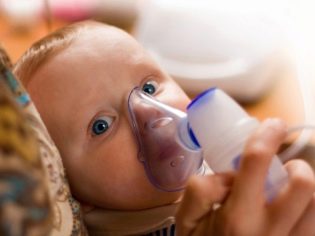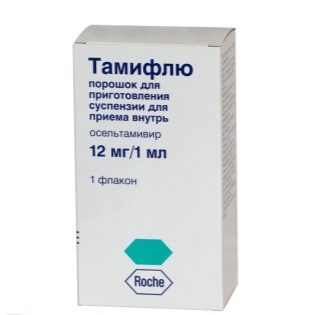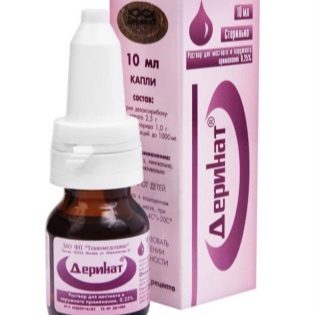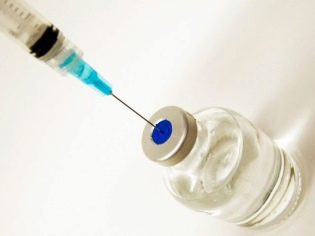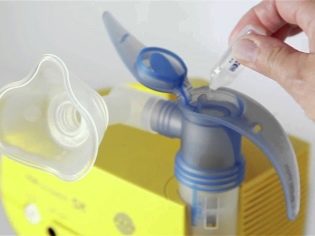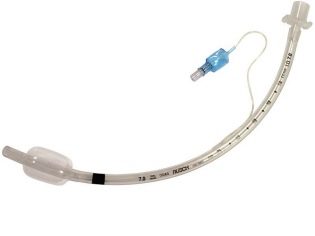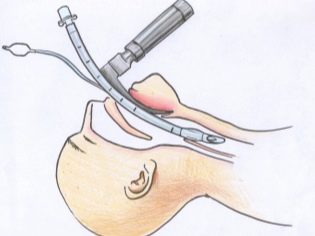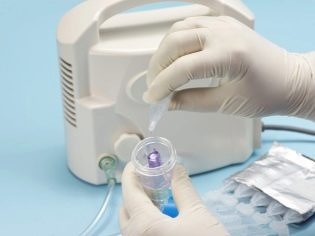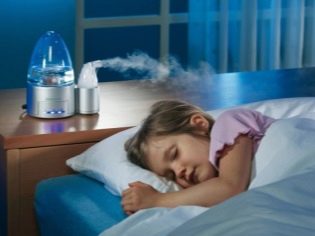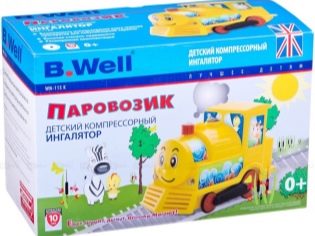Symptoms and treatment of false croup in children
None of the children are immune from such severe complications as false croup. Syndrome with stenosis (narrowing) of the larynx can occur suddenly on the background of any viral illness, severe cold and even allergies. How and why the false croup develops and how to provide the child with the necessary help, we will tell in this material.
What it is?
The croup may develop as a complication during severe inflammation of the larynx. Its occurrence is always closely associated with a strong swelling of the tissues, their increase in size, and, as a result, the narrowing of the larynx at the narrowest point - in the region of the vocal cords.
True croup is swelling and difficulty breathing only the ligament area, it occurs when diphtheria. False croup has a greater prevalence and a greater number of causes. It is less dangerous than the true, but with late treatment or incorrectly rendered assistance, it can also be fatal.
In children, the respiratory system has certain age differences that contribute to the development of croup. Their airways are loose and narrow, their larynx has smaller sizes and proportions than adults. As a result, the severe swelling that accompanies, for example, laryngitis or laryngotracheitis can literally “block” oxygen to a child.
At risk for such complications with SARS, influenza and other common and common diseases in childhood, - babies from birth to 3 years. This age accounts for more than half of all reported cases of false croup. After 6-7 years, children are much less likely to suffer such a complication, and after 10 years, the risks are generally almost zero.
The reasons
The most common cause of the development of false croup is parainfluenza virus, other causative agents of acute respiratory viral infections, influenza, acute respiratory infections. The most severe forms of complications with stenosis are caused by influenza viruses strains A and B, and, of course, adenoviruses. Bacteria themselves rarely cause inflammation and swelling of the larynx and the parts of the respiratory system adjacent to it. But they can join as a secondary infection.
Croup independently develops extremely rarely. In 99.9% of cases, false croup acts as a complication of rhinitis, pharyngitis, laryngitis, chickenpox, scarlet fever, and also chronic tonsillitis in the acute stage. As concomitant factors, a weak or weakened immunity of the child can be considered, which, due to age and the underlying disease, cannot resist the spread of the inflammatory process, prematurity, rickets, as well as other systemic diseases that a baby may have.
From the majority of diseases of the respiratory system, false croup differs in its ability to cause stenosis, in which the larynx is critically and sometimes completely closed, preventing the child from breathing.
Muscle cramps only increase stenosis. And mucus, which mucous membranes actively produce during the inflammatory process, “complements” this disturbing picture and creates an additional obstacle to the passage of air into the lower respiratory tract.
False croup can develop in stages, and may stop at one of the stages and begin to reverse development. At the initial stage, obstructive syndrome causes a slight oxygen starvation, but the children's organism, which can compensate for everything, gives depth and intensity to breathing and, as it can, compensates for the condition.
If the swelling increases and the stenosis becomes more pronounced, the stage of decompensation will begin. The lack of oxygen will hit the cardiovascular system, the kidneys and the brain. This can cause serious consequences, including asphyxia or death from cardiovascular insufficiency.
Kinds
False croup caused by inflammation of viral origin will be called viral, and if the stenosis is a consequence of bacterial infection, the croup will be called bacterial.
However, the information about the pathogen will be secondary, in the first place the doctor will put other information - what kind of croup in a child according to the degree of difficulty and severity of stenosis.
On this basis, false croup is:
- First degree This is compensated stenosis, in which the child has shortness of breath during activity, movement, exercise. Inhaling is more difficult than exhalation.
- Second degree These are croup with subcompensated disorders, in which shortness of breath appears in a child not only during exercise, but also in a state of rest.
- Third degree. In this condition, oxygen starvation develops, shortness of breath is strong, lips may turn blue, the skin becomes pale. The child is noticeably hard to breathe.
- Fourth degree. This is the last and most severe degree of complication in which deep hypoxia develops, which can be fatal. All organs and systems of a child’s body, especially the brain and the nervous system, suffer. Some changes, even if the child can be saved, will be irreversible.
Symptomatology
False croup does not develop from the very beginning of the underlying disease. Usually, the first signs of laryngeal edema with stenosis begin 2-3 days after the onset of the disease. Parents can notice the warning signs by the most important diagnostic symptom - the appearance of dry barking cough, which is often called “seal barking”.
Cough is very rude, hysterical. As the edema develops, hoarseness may appear, but the voice completely with false croup does not disappear, as it happens with true diphtheria. During crying, coughing voice will increase, and this is one of the main differences between false croup and true croup.
Another characteristic sign is noisy breathing. It changes from the first minutes of croup development. It becomes dry, whistling, the degree of sound effects directly depends on the degree of narrowing of the larynx, from the stage of stenosis. In the initial compensated stage, dyspnea will be insignificant, whistling episodic. At the second stage, shortness of breath will become dry and frequent, it will prevent the child from sleeping and concentrating, the first vascular disorders will begin - pallor of the skin will appear.
At the third decompensated stage, hoarseness, heart rhythm disturbances appear. The child ceases to be active, he is very drowsy, lethargic, because he is experiencing a strong oxygen starvation. The baby may begin hallucinations, delusions, episodes of loss of consciousness. At the last stage of false croup, the most characteristic symptoms disappear - barking cough and wheezing while inhaling. The child's blood pressure goes down, muscle cramps can appear, his consciousness goes away, plunging the baby into a hypoxic coma.
The most common attacks of false cereal occur at night. They are accompanied not only by severe shortness of breath and suffocating coughs, but also by panic fear, crying, and anxiety of the child. The baby must be given emergency assistance.
Diagnostics
With the correct determination of the diagnosis, pediatric doctors usually have no problems. Complaints about the main (often viral) disease, cough, runny nose, high fever, shortness of breath are sure to make the doctor listen more carefully to the child’s lungs. By the nature of wheezing, false croup is not like any other disease, it is almost impossible to confuse it.
To verify the viral origin of the disease, as well as to identify possible bacterial infections that may have joined, take a swab from the pharynx on bacposa. If the doctor has reason to believe that the child has started hypoxia caused by false croup, he will certainly carry out an analysis of the oxygen content in the blood, the so-called CBS (acid-base) analysis.
An x-ray helps to see where the larynx is narrowed, as well as to assess possible complications. Prescribe radiography of the lungs, as well as the paranasal sinuses.
Urgent Care
During a seizure with false croup, it is required to be able to provide emergency assistance correctly and quickly. It is to immediately call an ambulance. While the doctors are going, parents should try to calm the baby, because the impossibility of taking a full breath intimidates him, and during a fright, the muscles spasm and the respiratory failure becomes even stronger.
The child should be put to bed and covered with a warm blanket, all windows and air vents in the house should be opened, and if necessary, the child should be taken to the balcony so that he has constant access to fresh air. The influx of oxygen greatly facilitates the condition of the child.
Baby can be given a single dose of an antihistamine.permitted by age and in strict accordance with the age dosages. It may be "Suprastin", «Loratadine», «Tavegil». These drugs help to quickly reduce the swelling of tissues, and with a decrease in swelling, breathing will become more free.
There is no need to give other drugs., with the exception of antipyretics, if the child has a high fever. In order not to complicate his already serious condition with febrile convulsions, after the thermometer shows a temperature above 39.0 degrees, it is necessary to give "Paracetamol" or Ibuprofenbut acetylsalicylic acid should be avoided ("Aspirin"), because it in children can lead to the development of Ray's syndrome.
This first aid ends. All other manipulations are performed by a doctor. For severe forms of false croup, intubation may be necessary. Therefore, to refuse hospitalization in any case impossible. Once removed, the attack of false croup may well return within a few hours, but it will be more difficult and swift to proceed again.
Treatment
False croup mild can be treated at home. The pathology is moderately treated in the hospital, heavy croup requires conditions of the intensive care unit.
- Mild degree Inhalation is one of the most accessible methods of treating false croup in the mild stage with minor stenosis. For such procedures, it is best to use special devices - inhalers. Unlike a pot of boiling water or a pot of boiling water, steam inhalers, if properly used, do not cause burns to the respiratory tract.
When croup can not make the child inhalation with plant and essential components. They are irritants and can increase the degree of stenosis.
For inhalation, it is desirable to use normal water vapor or saline. The nebulizer for croup is ineffective, since its principle of action is to bring the fine particles of the drug substance to the lower respiratory tract (bronchi and lungs).
Prescribe inhalation must doctor. A child with a false croup, even if expressed in a very soft and mild stage, must be observed by a specialist, because the line between mild stenosis and critical narrowing of the airways is too thin.
The main treatment prescribed drugs required for the treatment of the underlying disease. These are usually some antiviral agents (if necessary - «Tamiflu», the remaining drugs - at the request of the parents, since most modern antiviral drugs do not have proven effectiveness), vitamins, antipyretic drugs based on paracetamol. A solution can be used to rinse the sore throat "Derinat".
- Medium degree. It is best to treat false croup with severe dyspnea and beginning hypoxia in the hospital, since quite serious medicines will be used in the therapy, many intramuscularly and intravenously. Usually, glucocorticosteroid hormones, such as "PrednisoloneOr Dexamethasone. In addition, the child is prescribed anti-inflammatory drugs, mostly non-steroidal, as well as the introduction of intravenous solutions with nutrients, vitamins. Separately, it should be said about the use of vascular drugs, the introduction of which reduces the negative effects of oxygen starvation on the brain and the nervous system of the child.
Dose "Dexamethasone" with medium-light false cereal is 0.6 mg per kilogram of baby weight. If the symptoms are not too pronounced, it is allowed to take the drug through the mouth. With moderate severity of croup, the drug is most often administered intramuscularly at the same dosage.
For children with such false croup, they often inhale with adrenaline. In this procedure, a nebulizer is used that disperses the medicine ("Epinephrine") into very small particles that quite easily penetrate the bronchi, trachea and lungs. Most often this helps to avoid intubation. However, among physicians, such treatment causes heated discussions - some experts say that inhaling adrenaline is a placebo effect, others are convinced that this is a great way to relieve an attack of respiratory failure. This inhalation is carried out in the hospital, since the child after it takes several hours to be under medical supervision.
- Heavy degree. In severe forms of false croup, a stay in the intensive care unit is indicated up to the moment when the threat of suffocation is bypassed. Then the child is transferred to the general department. The treatment is to introduce "Dexamethasone", inhalation with adrenaline, as well as the supply of oxygen from the outside. Every tenth child with heavy false croup requires endotracheal intubation. During the manipulation, a special tube is inserted into the trachea, which provides artificial airway patency.
However, not all so simple. Quite often, the tube, like a foreign body, injures the inflamed part of the respiratory organs, and then the so-called subglottic stenosis develops. That is why it is recommended to remove the tube as soon as the child begins to breathe on his own, without leaving it in the trachea "just in case."
Sometimes, in order to save the life of a child, a tracheostomy is performed. When it is in the trachea an incision is made, through which a special device, a kind of air intake, is brought out. One end of the tube is placed in the trachea, the other - outside. This will ensure that the child has access to air until the stenosis can be removed.
As a matter of urgency, every emergency doctor can do such operations even at home. If the child is in serious condition, if the doctor has fears that the young patient is not taken to the hospital alive, the doctor can cut the trachea with a regular kitchen knife, and use a spout from a porcelain teapot instead of a special tube.
Sometimes children with severe forms of false croup are inhaled with budesonide. This corticosteroid drug shows high efficiency in respiratory failure, however, its widespread use is impossible because of the huge number of side effects - it increases blood pressure, can lead to glaucoma, cataracts, cause adrenal cortical dysfunction, disrupts the production of sex hormones,causes severe allergic reactions and so on. Therefore, the drug is used only for vital indications, when the life of the child is at risk, and the expected benefits from the use of "Budesonide outweighs the possible risks.
Antibiotics for severe false cereal is not prescribed, if no associated bacterial ailments have been identified. Antiviral drugs are prescribed in rare cases, if severe stenosis has developed against the background of a strong viral infection. These antiviral drugs are administered intravenously or intramuscularly in a hospital setting.
Forecasts
Viral false croup is not as often fatal as it may seem. This is because it can self-sustain. Usually, the peak of the disease falls on 2-4 days, after which it takes about a week to reverse the development of stenosis.
In many respects, the prognosis depends on the stage at which the child was taken to the hospital or was called to the doctor’s house. The sooner parents and doctors noticed a narrowing of the airways, the earlier they took action and started treatment, the less likely it was that they would suffer from severe oxygen starvation and death.
Croup of moderate and severe seldom disappears without a trace. He usually leaves behind even with proper treatment some effects, such as brain dysfunction, neurological disorders, complications such as kidney and heart diseases.
Prevention
Due to the high prevalence of viral infections in childhood, especially in autumn and winter, the risk of developing false croup is also assessed as significant. This is especially true of children who often suffer from ARVI. That is why it is important that parents take care to comply with measures that will help avoid such a terrible and dangerous complication:
- In the child's room should be a humidifier. The relative humidity of 50-70% helps not only to protect the child from private diseases, but also speeds up the recovery of babies as much as possible if they still get sick with a respiratory infection.
- It is advisable to have an inhaler in the house. He will help if necessary to carry out all the necessary procedures at home.
- During the disease ARVI the child should drink more, breathe enough moist air. Proper treatment is important to prevent complications. Do not give drugs without the permission and prescription of a doctor, especially antibiotics. You do not need to give honey, red berries and put mustard plasters, so as not to aggravate the swelling with allergic edema. A newborn or eight-month-old baby, as well as all babies up to one year old must be shown to the doctor at the first sign of a respiratory infection.
- Hardening, fresh air and good nutrition help to strengthen the immune system and reduce the risks of complications.
Dr. Komarovsky will talk about the symptoms and treatment of false croup in the next video.


